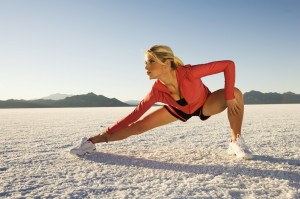Stretching
Posted on May 7th, 2013 by Andries Lodder

When embarking on any sort of physical activity a good warm up and stretching session is of utmost importance, this is the one thing all experts can agree on. However there is much debate as to which style of warm up or method of stretching that should be used. The idea of a warm up has several main objectives; this is to increase blood flow and cardiac output to the skeletal muscles and also to increase in muscle temperature thereby elevating enzyme activity level.
It is very important to be able to move a joint throughout its full range of motion (ROM). Inadequate flexibility can contribute to injury susceptibility due to the disturbance in the kinetic chain resulting in the compensation of other joints, such as the relationship between hamstring tightness and lower back pain.
Stretching has been linked to not only improving flexibility, but also decreasing the risk of injury and minimizing muscle soreness.
There are various types of stretching techniques all with different results, here are just a few:
Static Stretching
In a static stretch one assumes a position which applies a stretch to the targeted muscles, this position is held for 15-30 seconds. This is repeated 3 to 4 times, as the stretch is held the muscle relaxes and increase flexibility gradually.
Dynamic Stretching
Dynamic stretching is sport specific, you warm up dynamically and specifically related to the demands of the task at hand. Therefore mimicking your sporting movements. Dynamic stretching has shown to increase oxygen uptake, lower lactate concentration and improve efficiency of thermoregulation.
Proprioceptive Neuromuscular Facilitation (PNF)
PNF is commonly used to increase both active and passive ROM in both athletic and clinical environments. PNF allows for the greatest benefits in increasing ROM, however the benefits are mainly short term gains. With the PNF technique you utilize the shortening contraction of the opposing muscle to place the target muscle on stretch, this is then followed by a static contraction on the target muscle. So this technique involves alternation with contraction and relaxation in terms of both the agonist and antagonist muscles. It should ideally be done with a partner who understands the limits of a muscle when stretching. PNF has proven to have superior gains to other stretching techniques. However caution should be taken while performing this type of stretching.
Tweet